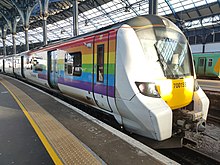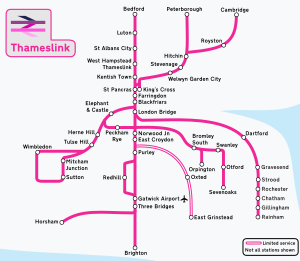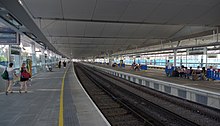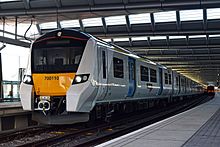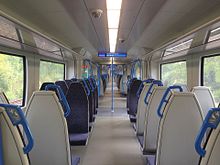
Southern is the brand name used by the Govia Thameslink Railway (GTR) train operating company on the Southern routes of the Thameslink, Southern and Great Northern franchise in England. It is a subsidiary of Govia, a joint venture between transport groups Go-Ahead and Keolis, and has operated the South Central franchise since August 2001 and the Gatwick Express service since June 2008. When the passenger rail franchise was subsumed into GTR, Southern was split from Gatwick Express and the two became separate brands, alongside the Thameslink and Great Northern brands.

Blackfriars, also known as London Blackfriars, is a central London railway station and connected London Underground station in the City of London. It provides Thameslink services: local, and regional and limited Southeastern commuter services to South East London and Kent. Its platforms span the River Thames, the only one in London to do so, along the length of Blackfriars Railway Bridge, a short distance downstream from Blackfriars Bridge. There are two station entrances either side of the Thames, along with a connection to the London Underground District and Circle lines.

Farringdon is an interchange station located in Clerkenwell, London, England, in the London Borough of Islington, just outside the boundary of the City of London for London Underground, Elizabeth line and National Rail services.

City Thameslink is a central London railway station within the City of London, with entrances on Ludgate Hill and Holborn Viaduct. The station is on the Thameslink route between Blackfriars to the south and Farringdon to the north.

Peckham Rye is a railway station in Peckham town centre, South London. The station is served by Southern, London Overground, Southeastern and Thameslink.

East Croydon is a railway station and tram stop in Croydon, Greater London, England, and is located in Travelcard Zone 5. At 10 miles 28 chains from London Bridge, it is the 20th busiest station in Britain, was the 10th busiest in 2020–21, is the busiest national rail station in London outside of fare zones 1 and 2 and is one of the busiest non-terminal stations in the country. It is one of three railway stations in the London Borough of Croydon with Croydon in their name, the others being West Croydon and South Croydon. A Tramlink tram stop is located immediately outside the main station entrance.

The Brighton Main Line is a major railway line in the United Kingdom that links Brighton, on the south coast of England, with central London. In London the line has two branches, out of London Victoria and London Bridge stations respectively, which join up in Croydon and continue towards Brighton as one line. The line is electrified throughout using the third rail system.
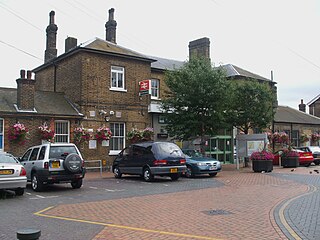
Norwood Junction railway station is a National Rail station in South Norwood in the London Borough of Croydon, south London, and is in Travelcard Zone 4. It is 8 miles 55 chains down the line from London Bridge.

Luton Airport Parkway railway station is on the Midland Main Line in England, serving south Luton and Luton Airport in Bedfordshire. The station is situated in Luton's Park Town district, being 29.27 miles (47.11 km) from London St Pancras between Harpenden to the south and Luton to the north. Its three-letter station code is LTN, also the IATA code for the airport.

West Hampstead Thameslink is a National Rail station on the Midland Main Line and is served by Thameslink trains as part of the Thameslink route between Kentish Town and Cricklewood. The station is in Travelcard Zone 2.

First Capital Connect (FCC) was a British train operating company, owned by FirstGroup, that operated the Thameslink and Great Northern sectors from April 2006 to September 2014 which later became the Thameslink, Southern and Great Northern (TSGN) franchise.

Thameslink was a train operating company in the United Kingdom owned by Govia that operated the Thameslink franchise between March 1997 and March 2006.
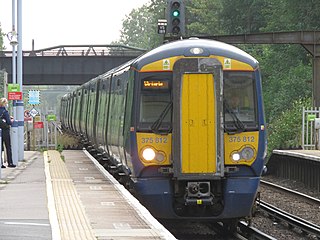
London & South Eastern Railway Limited, trading as Southeastern, was a British train operating company owned by Govia that operated passenger rail services in South East England. It was the key operator of commuter and regional services in South East London and Kent, and also served parts of East Sussex.
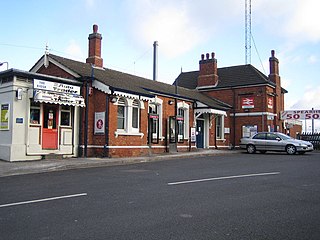
Leagrave railway station is located in Leagrave, a suburb in the north of Luton in Bedfordshire, England. Leagrave station is situated on the Midland Main Line 33¾ miles (54 km) north of London St Pancras International. The station is managed by Govia Thameslink Railway, and is served by the Thameslink route.

The Great Northern route is the name given to suburban rail services run on the southern end of Britain's East Coast Main Line and its associated branches. Services operate to or from London King's Cross and London Moorgate in London. Destinations include Hertford North, Welwyn Garden City, Stevenage, and Cambridge, and in peak hours, additional services run to Peterborough and King's Lynn. Services run through parts of Greater London, Hertfordshire, Bedfordshire, Cambridgeshire, and Norfolk.

Harpenden railway station is on the Midland Main Line in England, serving the town of Harpenden, Hertfordshire. It is 24 miles 51 chains (39.7 km) down the line from London St Pancras and is situated between St Albans City to the south and Luton Airport Parkway to the north. Its three-letter station code is HPD.

The Thameslink Programme, originally Thameslink 2000, was a £6 billion project in south-east England to upgrade and expand the Thameslink rail network to provide new and longer trains between a wider range of stations to the north and to the south of London. The development facilitated new cross-London journeys, which means that passengers no longer have to change trains in London. Work included platform lengthening, station remodelling, new railway infrastructure, and new rolling stock. The project was originally proposed in 1991 following the successful introduction of the initial Thameslink service in 1988. After many delays, planning permission was granted in 2006 and funding was approved in October 2007. Work started in 2009 and was completed on 18 September 2020, although trains over the new routes began running in 2018.
Network Rail's (NR) South London Route Utilisation Strategy (SLRUS), published in March 2008 (SLRUS) was the eighth Route Utilisation Strategy to be produced. By default, RUSs are established by the Office of Rail Regulation (ORR) unless the latter objects within 60 days. The RUS is included in NR's map as established.

Govia Thameslink Railway (GTR) is a train operating company that operates the TSGN rail franchise in England. Within the franchise, GTR runs trains under the sub-brands Thameslink, Great Northern, Southern and Gatwick Express. GTR is a subsidiary of Govia, which is itself a joint venture between the British Go-Ahead Group (65%) and French company Keolis (35%).

The Holborn Viaduct–Herne Hill line is a railway line between Holborn Viaduct in the City of London and Herne Hill in the London Borough of Lambeth. After the closure of Holborn Viaduct station the line ends at the south portal of Snow Hill tunnel merging into Snow Hill lines. From there the Widened Lines to St Pancras and Kentish Town are reached. Today the section north of Blackfriars is part of the Thameslink core. Originally being a branch line of the London, Chatham and Dover Railway (LCDR) towards the City of London, the line is sometimes called LCDR City Branch.
